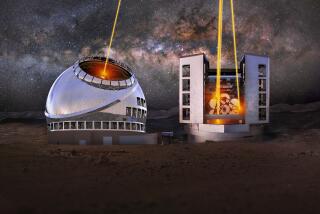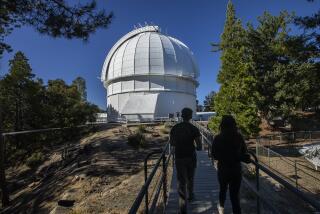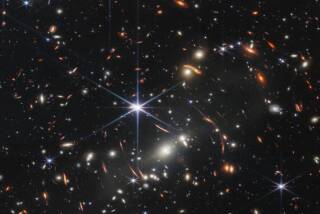‘400 Years of the Telescope
- Share via
It is the International Year of Astronomy, you more than likely do not know, and the quadricentennial of the invention that revolutionized the science. The birthday special “400 Years of the Telescope” airs tonight on KCET, and though it is, strictly speaking, 401 years since the first spyglasses appeared, it wasn’t until 1609 that Galileo made the improvements that turned it from an instrument of terrestrial convenience to one of celestial investigation. So calculate your azimuths, kids, and let’s party!
Made by and featuring people who know and care about telescopes, it is handsomely put together (in “4K resolution digital cinematography,” which does sound impressive), but also informed by a kind of gaiety that, given the subject, seems absolutely fitting. (Stars and planets and spiral nebulae -- what’s not to like?) It is not particularly heavy on science, past explaining a few simple things about lenses and prisms and changing notions of astral geometry, and various steps in the ongoing refinement of instrument and image.
More to the point, it’s a story of the way technology informs philosophy, as Ptolemy’s Earth-centered universe gives way to Copernicus’ heliocentric arrangement -- that’s the one where we rotate around the sun, a system he found “more pleasing to the mind.” (“It was a wonderful aesthetic idea,” says one of the show’s happy talking heads, “and it was right.”) In our own time, pictures of deep space have turned it into something more three-dimensional and colorful, more fluid and alive, than previously envisioned: It is not the old field of white pinhole lights through which the starships of our sci-fi films now sail, but multicolored towers of gas and dust, monuments to cosmic birth and death. It’s a whole new universe.
The telescopes themselves, and the buildings that house them, are beautiful in their own right, set on mountaintops around the world, up where the air is crisp and clear, and in space itself, where the air is so clear as to be perfectly absent. As the instruments get bigger and better, and they keep on building them bigger and better, the view goes deeper into the farthest reaches of everything -- just last week NASA’s Swift space observatory picked up an exploding star more than 13 billion light-years away, the farthest and oldest cosmic event yet witnessed -- and we grow that much less wrong about where we are.
--
--
‘400 Years of the Telescope’
Where: KCET
When: 9 tonight
Rating: TV-G (suitable for all ages)



